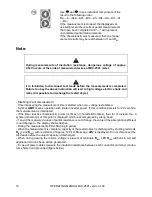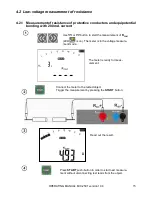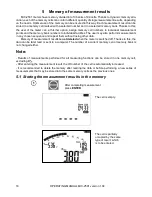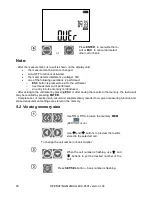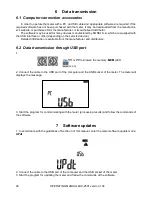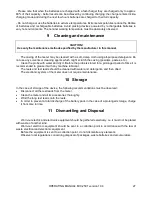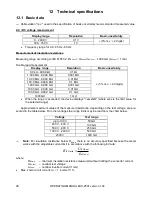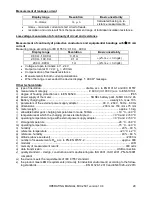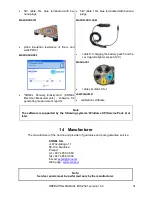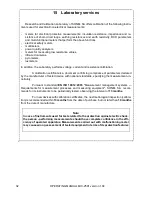
OPERATING MANUAL MIC-2501 version 1.04
26
Note:
- Due to interferences in the mains, the process of battery pack charging may finish prematurely. When
charging time is too short, turn off the meter and start charging again.
Additional information displayed by the meter
Signalling
Cause
Solution
Displayed message:
Err ACU
Hi°C
Temperature of the
battery pack is too
high!
Wait until the battery pack is cool. Start
charging process again.
Displayed message:
Err ACU
Lo°C
Temperature of the
battery pack is too low.
Wait until the battery pack is warm
enough. Start charging process again.
Displayed message:
Err ACU X
(where X is the number of error)
Emergency
Try to start the charging process again.
When powering the device from the
cigarette lighter socket, check whether
the socket supplies 12V voltage. If this
does not help, the battery pack may be
damaged - contact the manufacturer's
service.
No battery icon
(when the
charger is connected)
The battery pack is dis-
connected or dam-
aged.
Contact the manufacturer's service.
8.3 General principles regarding using Ni-MH rechargeable batteries
- Store the he rechargeable batteries (the meter) in a dry, cool and well ventilated place and protect
them from direct sunlight. The temperature of the environment in the case of prolonged storage should
not exceed 30°C. If the rechargeable batteries are stored for a long time in a high temperature, then
the occurring chemical processes may reduce their lifetime.
- Rechargeable batteries NiMH usually lasts for 500-1000 charging cycles. The rechargeable batteries
reach their maximum capacity after being formatted (2-3 charge and discharge cycles). The most im-
portant factor which influences the lifetime of rechargeable batteries is the level of their discharge. The
deeper the discharge level of the batteries, the shorter their lifetime.
- The memory effect is limited in the case of NiMH batteries. These batteries may be charged at any
point with no serious consequences. However, it is recommended to discharge them completely every
few cycles.
- During storage of Ni-MH rechargeable batteries they are discharged at the rate of approximately 20%
per month. Keeping rechargeable batteries at high temperatures may accelerate this process even
100%. In order to prevent excessive discharge of rechargeable batteries, after which it would be neces-
sary to format them, it is recommended to charge them from time to time (even if they are not used).
- Modern fast chargers detect both too low and too high a temperature of the battery pack and react to
the situation adequately. Too low temperature should prevent starting the process of charging, which
might irreparably damage rechargeable batteries. An increase of the temperature of the rechargeable
batteries is a signal to stop charging and is a typical phenomenon. However charging at a high ambient
temperature apart from reducing batteries' lifetime causes an accelerated increase of their temperature
and the result is that the batteries are not charged to their full capacity.

